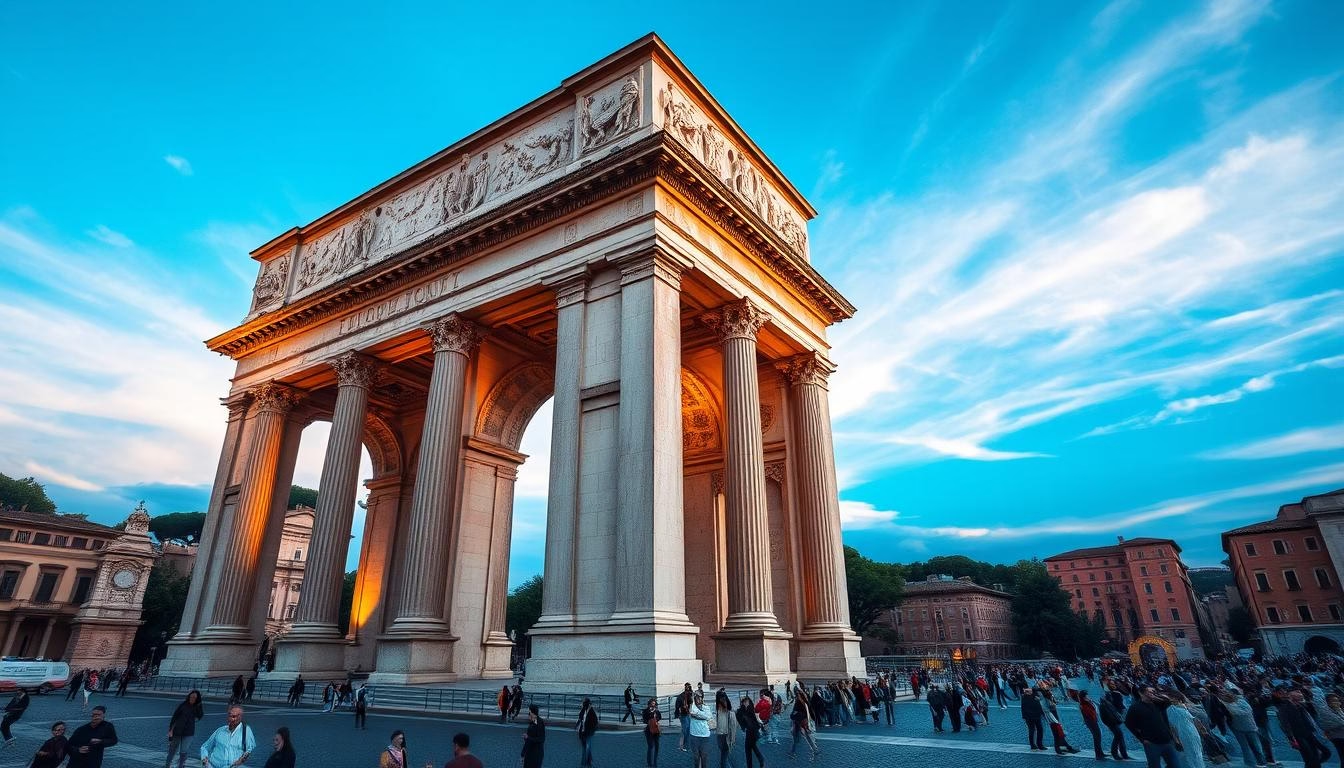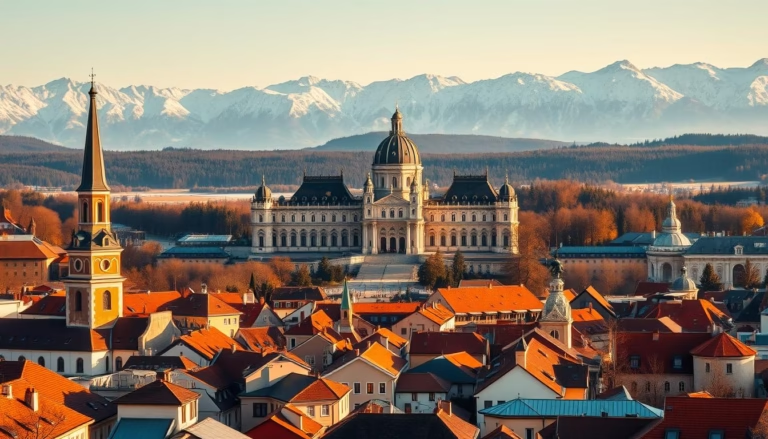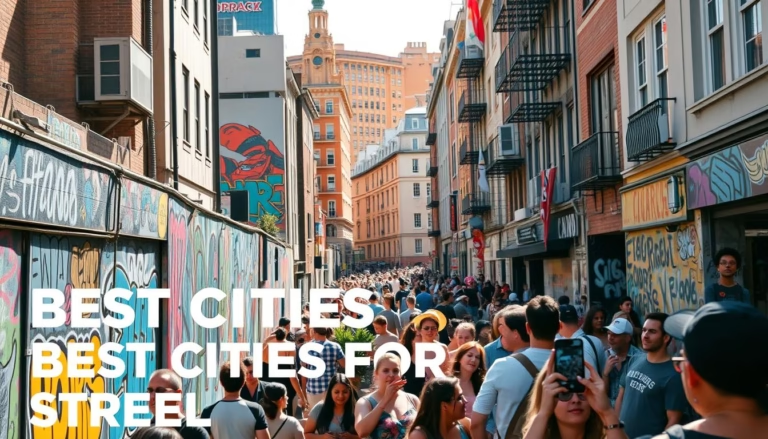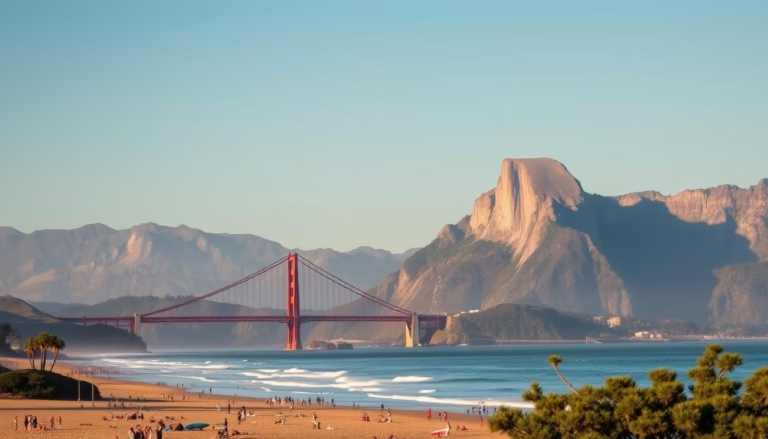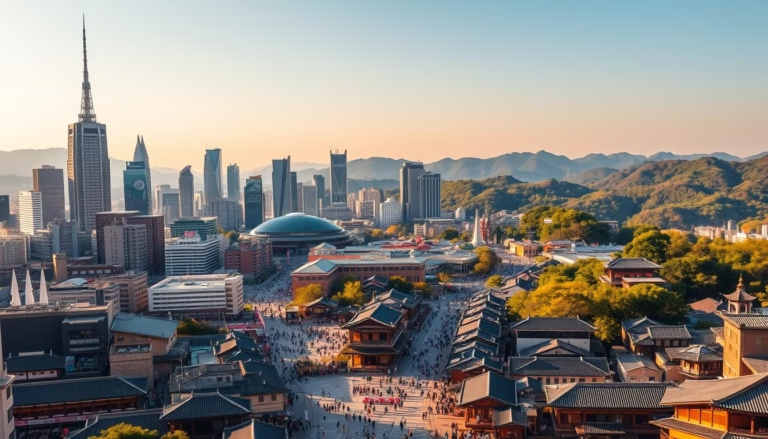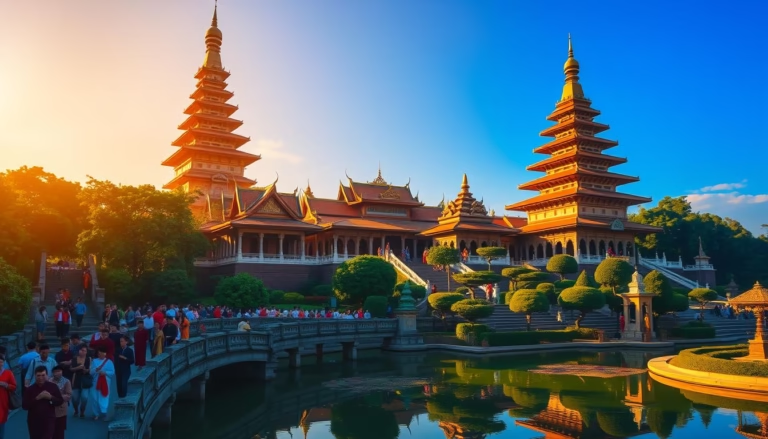Monumental Triumphal Arches: Symbols of Power and Victory
Imagine walking through a city and seeing a massive stone gateway towering above you. These grand structures, known as triumphal arches, have marked celebrations of power for thousands of years. First built by the Ancient Romans, they were designed to honor military victories and influential leaders.
Many of these arches still stand today, blending history with modern cityscapes. While their designs vary, most feature carved details that tell stories of battles, emperors, and cultural pride. From Europe to Asia, they remind us how societies have celebrated their greatest achievements.
What makes these monuments so enduring? They’re not just stone and mortar—they’re symbols of ambition. Emperors used them to showcase their legacy, but today, they also serve as gathering spots and tourist attractions. Their mix of art and history keeps them relevant across generations.
Key Takeaways
- Originated in Ancient Rome to celebrate military victories and leaders
- Combine artistic design with historical storytelling
- Found worldwide, adapting to different cultures over time
- Function as both landmarks and symbols of civic pride
- Influence modern architecture and public memorials
Historical Origins and Evolution of Triumphal Arches
The story of these iconic structures begins in the heart of ancient Rome. While their exact origins remain debated, historians agree Romans perfected the arch as a celebration of military success. Early versions served as temporary wooden gateways for victorious generals before evolving into permanent stone monuments.
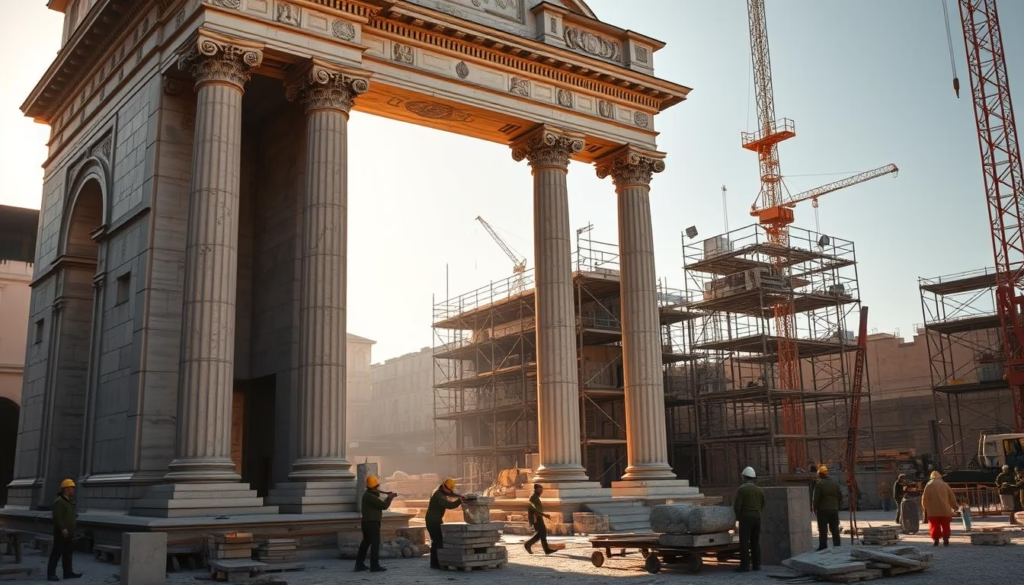
Ancient Foundations: More Than Stone Gateways
Roman emperors transformed simple arches into detailed history books. The Arch of Constantine near the Colosseum showcased carved battle scenes, while the Arch of Septimius Severus in the Roman Forum celebrated victories over the Parthians. These structures mixed art with politics, reminding citizens of imperial power.
| Feature | Roman Arches | Post-Roman Arches |
|---|---|---|
| Primary Purpose | Military victories | Political propaganda |
| Materials | Marble & limestone | Granite & bronze |
| Decoration | Battle reliefs | Royal symbols |
| Location | City centers | Capital landmarks |
From Rome to Renaissance Revival
After Rome’s decline, the arch concept lay dormant until European rulers revived it. French kings built arches to glorify their reigns, while Napoleon commissioned Paris’ Arc de Triomphe. This 19th-century shift turned military symbols into broader celebrations of cultural identity.
By blending Roman designs with local styles, new arches reflected regional values. The basic form remained, but details changed to honor different victory types—from territorial conquests to artistic achievements.
Architectural Features and Design Elements
These stone gateways speak through their classical details. While styles evolved, their core elements remained consistent across centuries. Architects blended strength and beauty through precise ratios – a 2:3 proportion between width and height became standard for balanced designs.
Classical Details: Cornices, Friezes, and Corinthian Columns
Three key features define these structures. Horizontal cornices crown the top, while decorative friezes often showcase battle scenes. The Corinthian columns framing Paris’ Arc de Triomphe demonstrate this order’s leafy capitals – a Roman favorite for victory monuments.
Brussels’ Cinquantenaire Arch reveals another approach. Its Ionic columns feature scroll-shaped tops, proving regional adaptations. Builders used local materials too – Roman marble gave way to Belgian granite while maintaining classical proportions.
Structural innovations hid in plain sight. Coffered ceilings reduced weight without sacrificing grandeur. The Arch of Caracalla’s bronze chariot required advanced metalwork, resting securely on its columns. These solutions show how form followed function in ancient engineering.
Modern arches borrow these timeless elements. Steel-reinforced concrete allows larger spans today, yet designers still echo the past. The triple-arch layout remains popular, creating rhythmic symmetry that draws the eye upward – just as Roman architects intended.
Exploring Top Global Examples in a Product Roundup
What do travelers photograph most when visiting famous cities? Often, it’s the stone gateways that anchor urban landscapes. These landmarks blend history with modern life, each telling its own story of cultural pride.
Iconic Monuments: From Arc de Triomphe to India Gate
Paris’ Arc de Triomphe dominates its roundabout like a stone sentinel. Built over 30 years, this 164-foot giant honors French soldiers from the Napoleonic era. Its walls name 660 military leaders, while the Tomb of the Unknown Soldier beneath it draws silent crowds daily.
New Delhi’s India Gate shows how European designs traveled. This 42-meter sandstone structure memorializes 70,000 Indian troops from World War I. Flames dance at its base during national ceremonies, blending British colonial forms with local traditions.
Unique Regional Variations and Their Historical Context
Mexico City’s Monumento a la Revolución reimagines the concept entirely. At 220 feet tall, this copper-domed arch houses a museum and observation deck. Built during political upheaval, it celebrates social change rather than military conquest.
From Lisbon’s Rua Augusta Arch marking earthquake recovery to Pyongyang’s 1982 tribute against Japanese rule, these structures adapt to local histories. Brooklyn’s Soldiers and Sailors Arch proves even democratic societies use the form—honoring Civil War veterans through public art.
Today, these sites serve dual roles. They’re selfie backdrops by day and symbols of identity by night. Their enduring appeal lies in making history feel present—stone pages from humanity’s shared storybook.
Modern Interpretations and Contemporary Products
Skylines worldwide now blend glass towers with stone landmarks in surprising ways. Architects reimagine classic forms using materials like carbon fiber and recycled steel, proving ancient design principles still shape our urban future.
Innovative Design Inspirations Derived from Historical Arches
Today’s builders borrow Roman proportions but add eco-friendly twists. Madrid’s Arco de la Victoria features solar panels in its crown, while Seoul’s floating arch uses lightweight alloys. These updates honor tradition while tackling climate challenges.
Replicas and Product Innovations in Urban Landscapes
Paris’ 1989 Sizun replica shows how cities relive history through careful recreation. New York’s temporary “Arch for Arch” installation used 3D-printed parts, demonstrating how digital tools revive classic forms for pop-up events.
Integrating Traditional Architecture with Modern Engineering
Advanced techniques let designers push boundaries safely. Tokyo’s earthquake-resistant arch combines Roman curves with shock-absorbing joints. Barcelona’s coral-inspired gateway uses parametric modeling—a far cry from chisel and hammer, yet equally awe-inspiring.
From memorial parks to shopping districts, these structures prove good design transcends time. They anchor neighborhoods while sparking conversations about heritage in our fast-changing world.
Significance of Monumental Triumphal Arches in Today’s Urban Landscape
Cities worldwide use stone gateways as anchors for urban identity. These structures guide foot traffic while telling stories through their carvings. Paris’ Arc de Triomphe demonstrates this perfectly, standing where twelve avenues meet like spokes on a wheel.
Cultural Impact and Legacy in City Planning
Modern planners position arches as visual magnets. Yellowstone’s Roosevelt Arch marks a park entrance, while London’s Marble Arch shapes Oxford Street’s flow. Their placement along key roads creates natural gathering spots for parades and protests alike.
Economic benefits follow these landmarks. Cafés and shops cluster around them, capitalizing on tourist foot traffic. Barcelona’s Arc de Triomf hosts food markets beneath its red bricks, proving ancient forms can fuel modern commerce.
These monuments also shape digital landscapes. Instagram posts tagged at New Delhi’s India Gate reach millions daily. City officials now light arches with LEDs for nighttime photo ops, blending history with 21st-century engagement.
- Organize chaotic urban spaces through strategic placement
- Boost local economies by attracting visitors and businesses
- Serve as backdrops for cultural events and digital content
- Create emotional connections between residents and their city
From military victory symbols to community hearts, these structures keep evolving. They remind us that stone can speak—if we design our cities to listen.
Conclusion
Across continents and centuries, stone gateways stand as silent storytellers of human ambition. These structures began as Roman victory markers but evolved into global symbols of shared memory. From Delhi’s flame-lit memorials to Paris’ star-shaped roundabout, they anchor cities while adapting to new meanings.
What unites them? A timeless blueprint for honoring achievement. Modern versions now celebrate social progress or technological leaps, yet their core purpose remains. They transform stone into emotion—pride, loss, hope—carving our collective story into cityscapes.
As urban spaces evolve, so do these landmarks. Solar-paneled crowns and earthquake-resistant designs show how ancient forms meet 21st-century needs. They remind us that celebrating milestones isn’t just about the past—it’s about building living history for generations yet to walk beneath their curves.
